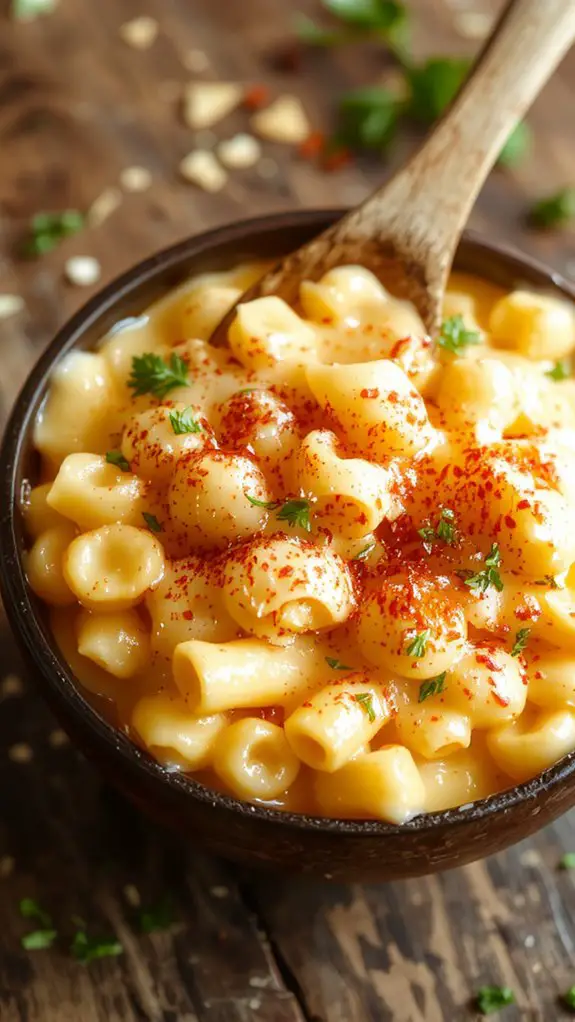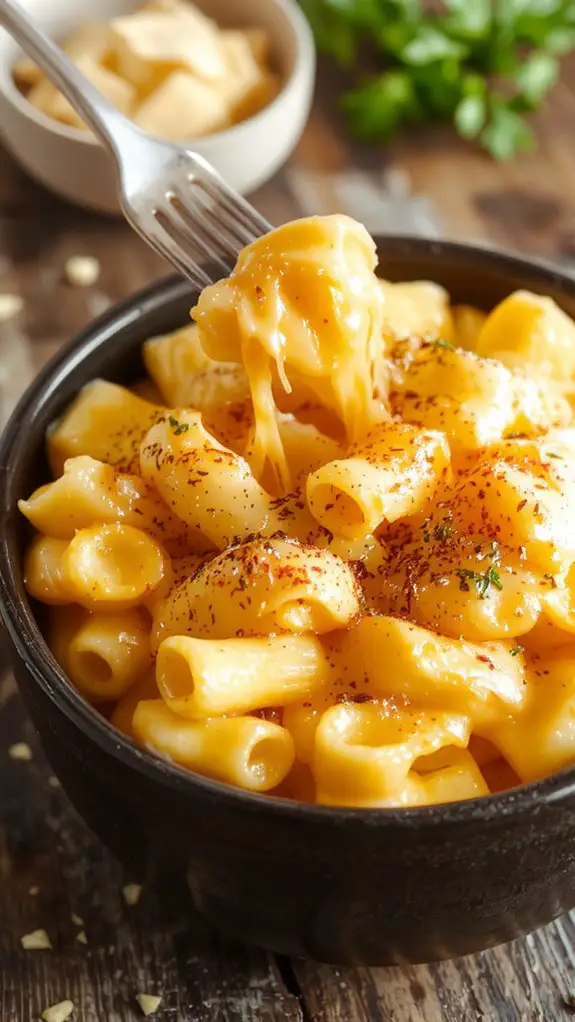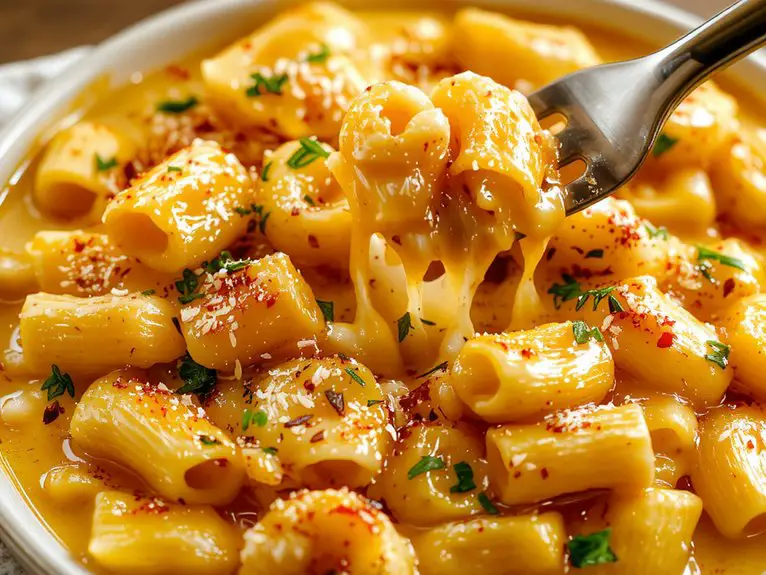I’ve always believed that mac and cheese should be simple yet unforgettable. This recipe combines sharp cheddar and a hint of mild cheese for a rich, creamy sauce that clings perfectly to al dente pasta. The secret lies in the smooth roux, which guarantees a velvety texture every time. Whether you bake it for a golden crust or enjoy it straight from the stove, this dish might just redefine your comfort food standards.
Recipe
There’s nothing quite like the creamy, cheesy comfort of homemade mac and cheese, and this recipe is the one I swear by—every single time. Forget the boxed stuff; this version is next-level delicious, with a velvety sauce that clings to every noodle and a golden, crispy topping that’ll have you scraping the dish clean.
The secret? A blend of sharp cheddar for punch and a touch of cream cheese for unbeatable smoothness. I’ve made this for picky kids, potlucks, and even fancy dinner parties (yes, mac and cheese can be fancy), and it never fails to disappear fast.
One bite of that gooey, cheesy goodness, and you’ll wonder why you ever settled for less. Let’s get cooking—this is mac and cheese done right.
Ingredients
The secret to the creamiest, most flavorful mac and cheese lies in the quality and balance of ingredients. Opt for ingredients that melt beautifully and deliver a rich, indulgent texture. Here’s what you’ll need, along with some chef-approved tips and swaps to make this dish your own.
- Elbow macaroni (8 oz): The classic choice for mac and cheese because its shape holds onto the cheese sauce perfectly. For a twist, try cavatappi or shells.
- Sharp cheddar cheese (2 cups, shredded): The star of the show! Sharp cheddar adds depth and tang. Always shred it yourself for a smoother melt—pre-shredded cheese contains anti-caking agents that can make the sauce grainy.
- Mild cheddar or Colby Jack cheese (1 cup, shredded): Adds creaminess and balances the sharpness of the cheddar. Feel free to experiment with Gouda or Fontina for a different flavor profile.
- Whole milk (1 ½ cups): Whole milk guarantees a rich, velvety sauce. For extra creaminess, swap in half-and-half or heavy cream.
- Unsalted butter (4 tbsp): Butter adds richness and helps create the roux for the cheese sauce. Salted butter works too, but adjust seasoning accordingly.
- All-purpose flour (¼ cup): Essential for thickening the sauce. For a gluten-free option, use cornstarch (1:1 ratio) or a gluten-free flour blend.
- Salt (1 tsp): Enhances all the flavors. Always taste and adjust as needed.
- Black pepper (½ tsp): Adds a subtle kick. Freshly cracked pepper gives the best flavor.
- Dash of nutmeg (optional): A tiny pinch elevates the dish with warmth and complexity.
- Breadcrumbs (½ cup, optional): For a crispy topping, mix with melted butter and toast before sprinkling over the mac and cheese.
Little Wins: Toss in a handful of cooked bacon, sautéed onions, or roasted garlic for a gourmet upgrade.
Garnish with fresh parsley or chives for a pop of color.
How to Make the Best Creamy Stovetop Mac And Cheese

– Begin by boiling water in a large pot.
Add a generous pinch of salt—this seasons the pasta from the inside out, enhancing its flavor.
Once the water reaches a rolling boil, add the macaroni and cook according to the package instructions, aiming for al dente.
Overcooking can lead to mushy mac and cheese.
– While the pasta cooks, prepare the cheese sauce.
In a separate saucepan, melt butter over medium heat.
Stir in flour to create a roux, cooking it for about a minute to eliminate the raw flour taste.
This step guarantees the sauce thickens properly.
– Slowly whisk in milk.
Gradually add the milk to the roux, whisking constantly to avoid lumps.
This gradual addition helps create a smooth, velvety base.
Continue cooking until the mixture thickens slightly, about 3-5 minutes.
– Add the cheese in batches.
Remove the saucepan from heat and stir in the shredded cheese a handful at a time.
Allowing each addition to melt before adding more guarantees a creamy, lump-free sauce.
Pro tip: Use freshly shredded cheese for better melting—pre-shredded varieties contain anti-caking agents that can make the sauce grainy.
– Combine the pasta and sauce.
Drain the cooked macaroni and return it to the pot.
Pour the cheese sauce over the pasta and gently stir until evenly coated.
Avoid overmixing, as this can break down the pasta and make it sticky.
– Adjust seasoning and serve.
Taste the mac and cheese and season with salt, pepper, or a pinch of nutmeg if desired.
Nutmeg adds a subtle depth of flavor that complements the cheese beautifully.
Serve immediately while hot and creamy.
– Optional mix-ins.
If you’re feeling adventurous, fold in cooked bacon, sautéed veggies, or a dash of hot sauce for extra flair.
Customize it to your taste!
Nutrition
Mac and cheese is a classic comfort food that can be enjoyed any time. Here’s the nutritional breakdown for a standard serving.
| Nutrient | Amount per Serving |
|---|---|
| Calories | 350 kcal |
| Fat | 12g |
| Carbohydrates | 45g |
| Protein | 15g |
| Sodium | 600mg |
Chef Tips
When making mac and cheese, I always recommend using freshly grated cheese instead of pre-shredded because it melts smoother and creates a creamier sauce. Another tip is to cook the pasta just shy of al dente—it’ll finish cooking in the oven.
For extra flavor, I add a pinch of mustard powder or cayenne.
To conclude, don’t skip the breadcrumb topping; it adds a satisfying crunch.






